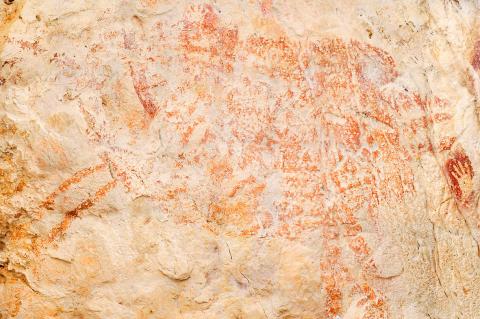Scientists have found the oldest known example of an animal drawing: a red silhouette of a bull-like beast on the wall of a remote Indonesian cave.
The sketch is at least 40,000 years old, slightly older than similar animal paintings found in famous caves in France and Spain.
Until a few years ago, experts believed that Europe was where our ancestors started drawing animals and other figures.

Photo: Luc-Henri Fage / kalimanthrope.com / AP
However, the age of the drawing reported on Wednesday in the journal Nature, along with previous discoveries in Southeast Asia, suggest that figurative drawing appeared in both continents at about the same time.
The findings fuel discussions about whether historical or evolutionary events prompted this near-simultaneous “burst of human creativity,” said lead author Maxime Aubert, an archeologist and geochemist at Griffith University in Australia.
Remote limestone caves in Borneo have since the 1990s been known to contain prehistoric drawings. To reach them, Aubert and his team used machetes to hack through thick jungle in a verdant corner of the island.
Strapping on miners’ helmets to illuminate the darkness, they walked and crawled through caves decorated with hundreds of ancient designs, looking for artwork that could be dated. They needed to find specific mineral deposits on the drawings to determine their age with technology that measures uranium decay.
“Most of the paintings we actually can’t sample,” Aubert said.
Aubert and his fellow researchers reported in 2014 on cave art from the neighboring Indonesian island of Sulawesi. They dated hand stencils, created by blowing red dye through a tube to capture the outline of a hand pressed against rock, to almost 40,000 years ago.
Now, with the Borneo cave art, the scientists are able to construct an approximate time line of how art developed in the area.
In addition to the bull, which is about 1.5m wide, they dated red and purple-colored hand stencils and cave paintings of human scenes.
After large animal drawings and stencils, “it seems the focus shifted to showing the human world,” Aubert said.
About 14,000 years ago, the cave-dwellers began to regularly sketch human figures doing things such as dancing and hunting, often wearing large headdresses. A similar transition in rock art subjects happened in the caves of Europe.
“That’s very cool, from a human point of view,” said Peter Veth, an archeologist at the University of Western Australia, who was not involved in the study. “People adopted similar strategies in different environments as they became more modern.”
Borneo was still connected to mainland Southeast Asia when the first figurative drawings were made about 40,000 years ago — which is also about the time that the first modern humans arrived in Europe.
The earliest drawings of animals in the French cave of Chauvet have been dated to about 33,500 to 37,000 years ago.
Whether new waves of people migrating from Africa brought the skills of figurative cave painting with them or whether these arts emerged later remains unclear.
Scientists have only a partial record of global rock art. The earliest cave etchings have been found in Africa and include abstract designs, such as crosshatches, dating to about 73,000 years ago.
The next stage of research in Indonesia is to include excavations to learn more about the people who made these paintings. A few sites have already been identified, containing human bones, prehistoric jewelry and remains of small animals.
As for the red bull, its meaning remains a mystery.
“We think it wasn’t just food for them — it meant something special,” Aubert said.

END OF AN ERA: The vote brings the curtain down on 20 years of socialist rule, which began in 2005 when Evo Morales, an indigenous coca farmer, was elected president A center-right senator and a right-wing former president are to advance to a run-off for Bolivia’s presidency after the first round of elections on Sunday, marking the end of two decades of leftist rule, preliminary official results showed. Bolivian Senator Rodrigo Paz was the surprise front-runner, with 32.15 percent of the vote cast in an election dominated by a deep economic crisis, results published by the electoral commission showed. He was followed by former Bolivian president Jorge “Tuto” Quiroga in second with 26.87 percent, according to results based on 92 percent of votes cast. Millionaire businessman Samuel Doria Medina, who had been tipped

ELECTION DISTRACTION? When attention shifted away from the fight against the militants to politics, losses and setbacks in the battlefield increased, an analyst said Recent clashes in Somalia’s semi-autonomous Jubaland region are alarming experts, exposing cracks in the country’s federal system and creating an opening for militant group al-Shabaab to gain ground. Following years of conflict, Somalia is a loose federation of five semi-autonomous member states — Puntland, Jubaland, Galmudug, Hirshabelle and South West — that maintain often fractious relations with the central government in the capital, Mogadishu. However, ahead of elections next year, Somalia has sought to assert control over its member states, which security analysts said has created gaps for al-Shabaab infiltration. Last week, two Somalian soldiers were killed in clashes between pro-government forces and

Ten cheetah cubs held in captivity since birth and destined for international wildlife trade markets have been rescued in Somaliland, a breakaway region of Somalia. They were all in stable condition despite all of them having been undernourished and limping due to being tied in captivity for months, said Laurie Marker, founder of the Cheetah Conservation Fund, which is caring for the cubs. One eight-month-old cub was unable to walk after been tied up for six months, while a five-month-old was “very malnourished [a bag of bones], with sores all over her body and full of botfly maggots which are under the

BRUSHED OFF: An ambassador to Australia previously said that Beijing does not see a reason to apologize for its naval exercises and military maneuvers in international areas China set off alarm bells in New Zealand when it dispatched powerful warships on unprecedented missions in the South Pacific without explanation, military documents showed. Beijing has spent years expanding its reach in the southern Pacific Ocean, courting island nations with new hospitals, freshly paved roads and generous offers of climate aid. However, these diplomatic efforts have increasingly been accompanied by more overt displays of military power. Three Chinese warships sailed the Tasman Sea between Australia and New Zealand in February, the first time such a task group had been sighted in those waters. “We have never seen vessels with this capability